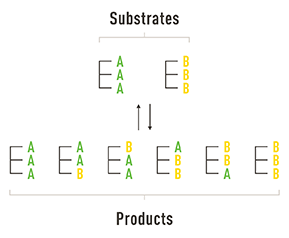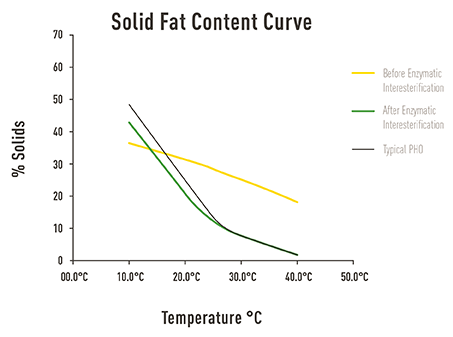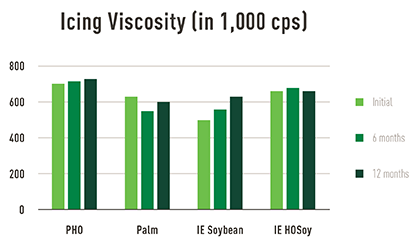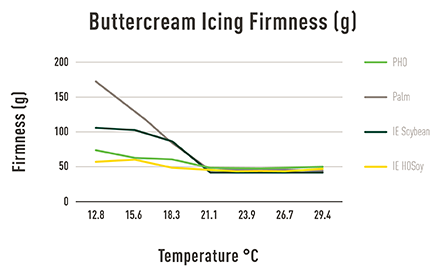The icing on the cake
By Frank Flider
October 2018
- Partially hydrogenated oil (PHO) functionality is driven by trans (eg., elaidic acid).
- High-oleic soybean oil provides an element of elaidic acid functionality.
- A multi-year collaborative research effort between Qualisoy and Stratas Foods, LLC has determined that enzymatically interesterified high-oleic soybean oil shortenings are a suitable drop-in alternative to partially hydrogenated oils (PHOs).
The US Food and Drug Administration’s (FDA) determination that partially hydrogenated oils (PHOs) are no longer “generally recognized as safe” (GRAS) became effective on June 18, 2018. PHOs may no longer be used in foods sold in the United States without food additive approval. Eliminating this trans fatty acid source from the diet is certainly good news for the public’s health, but it represents a number of challenges for food producers. In particular, foods that depend upon the function of trans fatty acids for structure, texture, mouthfeel, and eating qualities must be reformulated using non-trans fatty acid alternatives.
In the baking industry, one of the more challenging issues is finding a functional PHO replacement for icing and frosting, particularly the high-fat creamy buttercream-style icing. Buttercream icing is a blend of sugar, shortening, milk solids, salt, water, and flavorings. The shortening provides much of the texture, stability, and eating qualities of the icing. The high levels of trans fatty acids in PHO shortenings provided the ideal melting properties desired for high-quality icings.
A baking shortening is primarily comprised of oils and fats. The main difference between the two components is their physical form at room temperature; oils are liquid while fats are solid.
Traditionally, a baking and icing shortening was formulated with a partially hydrogenated soybean oil to which a fully hydrogenated soybean and/or cottonseed oil was added. The resultant product was comprised of triaclyglycerols with melting points which ranged from a low of -24.2°C for trilinolenic to a high of 73.1°C for tristearic, functionally held together by the trans form of trioleic, denoted as trielaidic with a mid-range melt point of 42.0°C [Daniel Swern (ed.), Bailey’s Industrial Oil and Fat Products (1979). John Wiley & Sons, Hoboken, New Jersey, USA, pp. 194–195.]
This combination of low-melting-point and high-melting-point triacylglycerides functionally held together by trans isomers like trielaidic is no longer available without PHOs. Food scientists, required to utilize non-PHO alternatives, are under pressure to achieve non-PHO based approaches that deliver comparable consumer experience for the end use products as it relates to taste and quality.
Among the first PHO alternatives evaluated were palm oil-based shortenings and blends of hard fats and liquid oils. Challenges with these alternatives may include grainy mouthfeel and texture as well as a darker or yellow color. In order to use these early alternatives, process modifications such as changing mix times and speeds, batter temperature, and ratios of key ingredients may be required. In short, it may be necessary to reformulate the product in order to replace the PHO shortening with a palm-based shortening, and therefore, it is not a true drop-in solution.
Blends of palm or another hardstock, such as fully hydrogenated soybean oil, with liquid oil tend to result in shortenings that are higher in polyunsaturates than typically observed with a PHO shortening with a given solid fat content (SFC) profile. The presence of these polyunsaturates has a negative effect on the icing structure as well as mouthfeel, viscosity and stability.
A newer alternative is enzymatically interesterified (EIE) high-oleic soybean oil shortening. EIE high oleic soybean shortening has a composition similar to high-trans PHO shortenings. Because of this compositional similarity, functional properties of PHOs can be more closely approximated than is possible with other alternatives.
Specifically, two components are responsible; utilization of an oleic-acid-rich vegetable oil like high-oleic soybean oil, coupled with the process of enzymatic interesterification. The oleic fatty acid in the trioleic form, as the cis alternative to trielaidic, has a published melt point value of 5.0°C. While this is not as high in magnitude as the trielaidic melting point of 42.0°C, it is a positive step forward to achieving the functionality of PHOs without contributing trans fat. This is due to utilizing trioleic as a mid-melting point material between -24.2°C for trilinolenic to 73.1°C for tristearic.
The process of enzymatic interesterification is a lipase enzyme catalyzed fatty acid randomization reaction at triacylcglyceride positions 1 and 3 within and between triacylcglycerides. The outcome of this process results in modification of melting point and functional crystallization properties without changing the overall fatty acid composition of the base oil blend (Figs. 1 and 2). Specifically, expansion of the fatty acid combination types, made possible by the lipase enzyme catalyzed randomization at positions 1 and 3, results in a greater differentiated array of triacyclglycerides than what is achieved via only physically blending. The combination of base oil inputs, specifically high oleic soybean oil, subjected to the process of enzymatic interesterification, results in shortening bases featuring comparable melting characteristics to the PHO shortening bases they were designed to replace.
FIG. 1. Stylized triacyclglyceride fatty acid combination types expansion from oil denoted as A and fat denoted as B subjected to EIE
FIG. 2. Solid fat content (SFC) for various oil blends
In a study conducted by Qualisoy and Stratas Foods, EIE high-oleic soybean shortening was compared to PHO shortening, EIE conventional soybean oil and a palm-soy blend in the production of a buttercream icing. EIE high oleic soybean oil shortening produced the most similar viscosity to the PHO shortening (Fig. 3). When using a texture analyzer, the EIE high oleic soybean shortening outperformed all other shortenings, including PHO, showing the least change in firmness over a range of temperatures (Fig. 4). Icing made with palm showed the most change, especially at colder temperatures, indicating possible difficulties in spreadability, mouthfeel, and overall functionality.
FIG. 3. Buttercream icing viscosity variances observed when utilizing icing shortening options at time 0, 6, and 12 months
Out of all available PHO alternatives, EIE high-oleic soybean shortening just may be the icing on the cake.
FIG. 4. TA-X2 firmness values for buttercream icing prepared with various icing shortenings
Frank Flider, Qualisoy consultant, is active in the Institute of Food Technologists and American Oils Chemists’ Society. He serves on the editorial advisory committee for Inform and the editorial board for the Journal of the American Oil Chemists’ Society. Flider is the author of numerous technical papers and holds several US patents. He brings more than 40 years of technical, managerial, and marketing experience in the oilseed and agricultural biotech industries to Qualisoy. He can be contacted at fflider@mac.com.
Roger Daniels, vice president research, development, and innovation, for Stratas Foods, LLC, is an inventor, author, and edible oils industry expert with numerous patents in edible oil products and processing. Prior to joining Stratas, Daniels led the R&D team for Bunge Oils, a division of Bunge North America, and held positions of increasing responsibility with Campbell Soup Company, ConAgra Foods, and ABITEC Corporation. He can be contacted at roger.daniels@stratasfoods.com.




